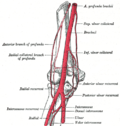Elbow
Elbow
The elbow is a complex hinge joint formed by the articulation of three bones: the humerus, radius, and ulna. It is a fundamental part of the human skeletal system and plays a crucial role in upper limb movement.
Anatomy[edit]
The elbow joint is where the long bone at the top of your arm, known as the humerus, meets the two bones in your forearm, known as the radius and ulna. It is one of the largest joints in the body and is surrounded by muscles, ligaments, and tendons that enable a wide range of movements.
Bones[edit]
- Humerus: The humerus is the long bone in the upper arm. It has two articulating surfaces that interact with the radius and ulna to form the elbow joint.
- Radius: The radius is one of the two bones in the forearm. It is located on the thumb side of the arm and rotates to allow the hand to turn palm up.
- Ulna: The ulna is the other bone in the forearm, located on the pinky side. It has a hook-like process, the olecranon, which forms the bony prominence of the elbow.
Ligaments and Tendons[edit]
The elbow joint is supported by several ligaments and tendons, including the annular ligament, the radial collateral ligament, the ulnar collateral ligament, and the quadrate ligament.
Function[edit]
The elbow joint allows for two basic movements: flexion and extension. Flexion occurs when the angle of the joint decreases, as in bending the elbow to bring the hand closer to the shoulder. Extension is the opposite movement, increasing the angle of the joint to straighten the arm.
Conditions and Disorders[edit]
There are many conditions and disorders that can affect the elbow, including tennis elbow, golfer's elbow, bursitis, arthritis, and fractures. These conditions can cause pain, swelling, stiffness, and limit the range of motion of the elbow.
Treatment[edit]
Treatment for elbow conditions and disorders depends on the specific diagnosis and may include rest, physical therapy, medication, and in some cases, surgery.
See Also[edit]
|
|
|
-
Elbow
-
Diagram of the elbow joint
-
Bones of the right arm. Anterior aspect.
-
Bones of the right arm. Posterior aspect.
-
The right humerus. Anterior view.
-
The right humerus. Posterior view.
-
The ligaments of the elbow joint. Anterior view.
-
The supinator.
-
Elbow
-
Elbow
-
Elbow
-
X-ray of ventral dislocation of the radial head with calcification of annular ligament
Ad. Transform your life with W8MD's Budget GLP-1 injections from $75


W8MD offers a medical weight loss program to lose weight in Philadelphia. Our physician-supervised medical weight loss provides:
- Weight loss injections in NYC (generic and brand names):
- Zepbound / Mounjaro, Wegovy / Ozempic, Saxenda
- Most insurances accepted or discounted self-pay rates. We will obtain insurance prior authorizations if needed.
- Generic GLP1 weight loss injections from $75 for the starting dose.
- Also offer prescription weight loss medications including Phentermine, Qsymia, Diethylpropion, Contrave etc.
NYC weight loss doctor appointmentsNYC weight loss doctor appointments
Start your NYC weight loss journey today at our NYC medical weight loss and Philadelphia medical weight loss clinics.
- Call 718-946-5500 to lose weight in NYC or for medical weight loss in Philadelphia 215-676-2334.
- Tags:NYC medical weight loss, Philadelphia lose weight Zepbound NYC, Budget GLP1 weight loss injections, Wegovy Philadelphia, Wegovy NYC, Philadelphia medical weight loss, Brookly weight loss and Wegovy NYC
|
WikiMD's Wellness Encyclopedia |
| Let Food Be Thy Medicine Medicine Thy Food - Hippocrates |
Medical Disclaimer: WikiMD is not a substitute for professional medical advice. The information on WikiMD is provided as an information resource only, may be incorrect, outdated or misleading, and is not to be used or relied on for any diagnostic or treatment purposes. Please consult your health care provider before making any healthcare decisions or for guidance about a specific medical condition. WikiMD expressly disclaims responsibility, and shall have no liability, for any damages, loss, injury, or liability whatsoever suffered as a result of your reliance on the information contained in this site. By visiting this site you agree to the foregoing terms and conditions, which may from time to time be changed or supplemented by WikiMD. If you do not agree to the foregoing terms and conditions, you should not enter or use this site. See full disclaimer.
Credits:Most images are courtesy of Wikimedia commons, and templates, categories Wikipedia, licensed under CC BY SA or similar.
Translate this page: - East Asian
中文,
日本,
한국어,
South Asian
हिन्दी,
தமிழ்,
తెలుగు,
Urdu,
ಕನ್ನಡ,
Southeast Asian
Indonesian,
Vietnamese,
Thai,
မြန်မာဘာသာ,
বাংলা
European
español,
Deutsch,
français,
Greek,
português do Brasil,
polski,
română,
русский,
Nederlands,
norsk,
svenska,
suomi,
Italian
Middle Eastern & African
عربى,
Turkish,
Persian,
Hebrew,
Afrikaans,
isiZulu,
Kiswahili,
Other
Bulgarian,
Hungarian,
Czech,
Swedish,
മലയാളം,
मराठी,
ਪੰਜਾਬੀ,
ગુજરાતી,
Portuguese,
Ukrainian














